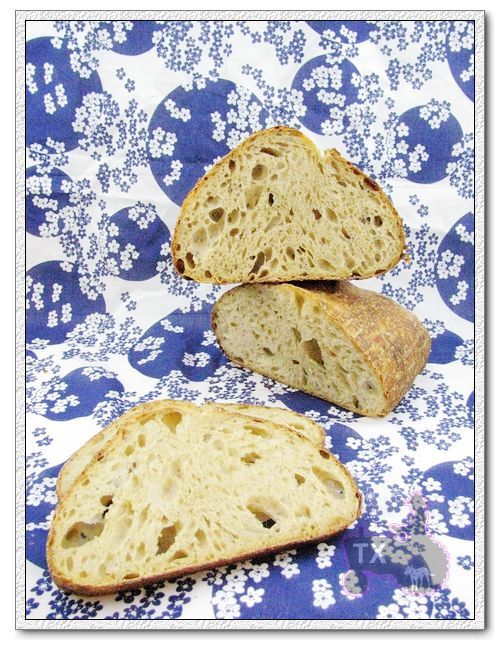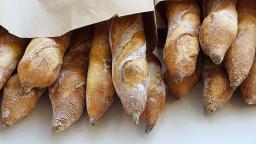While I have been baking in the last several weeks, most of it has been geared to sandwich loaves. Don't get me wrong; that is some pretty important baking. While it has been nourishing to the body, it hasn't been anything to stir the soul. I've had some old favorites: Clayton's Honey Lemon Whole Wheat and plain old honey whole wheat. I gave Beatrice Ojakangas' Granary Bread a try. Lovely stuff, but not at all anything that qahtan or others who have had the real thing would recognize as such. Essentially, it's honey whole wheat (um, I'm beginning to see a theme emerging here) with golden syrup subbed in for the honey. I'm going to digress for a moment. For all of you in the U.S. who have been wondering what on earth golden syrup is, here's the inside scoop: it's molasses. Yes! Really! A very light, mildly flavored grade of molasses, but molasses none the less. There. Now you know.
I've also been experimenting with some rye breads. The most noteworthy was a spectacular flop of the Sour Rye, year 1939, which came to my attention via Shiao Ping's blog. It looked and sounded so lovely in Shiao Ping's post and I'd been wanting to venture further into the rye world, so I thought I would give it a try. The first bad decision (I won't bore you with the entire list) was to opt for the free-form loaf, rather than the panned loaf. Being in full "never say die" mode (not readily distinguishable from denial), I soldiered on to the bitter end and was rewarded with something that had the general dimensions and texture of a 1x8 pine board, albeit somewhat darker. The flavor was worlds better than pine, but the amount of chewing necessary to extract the flavor made the whole enterprise unrewarding. Hence, my retreat to Ms. Ojakangas' book and the selection of her version of Granary Bread. A man's gotta eat, after all.
This weekend, still smarting from last week's debacle and still wanting rye bread, I hauled out Mark Sinclair's formula for Sour Rye bread. This I've made before, and in quantity, so I know how it works and how it is supposed to turn out. There are some differences between my execution and Mark's. First, he's a professional baker and I am not. Second, he uses dark rye and what I had on hand was medium rye. Third, he has some really big and really cool toys, while I was doing all of my mixing by hand. Since my use of Mark's formula is by his permission and a consequence of my internship at his Back Home Bakery, I'm not at liberty to share it here. If you really, really want to make this bread, sign up whenever Mark offers opportunities to intern with him. If you want something very close to Mark's bread, look up Eric's Fav Rye on this site. Mark started with that and made some adjustments that suit his selection of ingredients and production scheme. Both are excellent breads and they are very nearly the same bread.
As noted, I have medium rye flour on hand, so my bread came out somewhat lighter than Marks. Since I don't have a mixer here, I mixed by hand. Initially, the mixing was primarily to combine the ingredients uniformly. Since Mark relies on the mixer for kneading as well as mixing, I continued to work the dough in the bowl in what was essentially a stretch and fold maneuver to develop the dough's gluten network. As the dough became more cohesive, I dumped it out on the counter for some "slap and fold" or "French fold" kneading, a la Richard Bertinet. This worked very effectively to finish the dough's development. The dough was then gathered into a loose boule and placed in a greased bowl for the bulk ferment. After the dough had approximately doubled, it was divided in three pieces of about 710 grams each and pre-shaped. After resting a few minutes, the dough was then given its final shape and placed on a Silpat-lined baking sheet for final fermentation, lightly covered with oiled plastic wrap to prevent drying. As the dough was nearing the end of the final fermentation, I pre-heated the oven. When the oven was ready, the loaves were uncovered, brushed with egg wash, liberally sprinkled with poppy seeds and slashed. The baking sheet was put in the oven and hot water was put into the steam pan on the lower rack. Half-way through the bake, I rotated the loaves so that they would bake evenly, even though I was using the convection setting. I also pulled them off the baking sheet and let them bake directly on the oven rack so that they would bake and color evenly. They were a bit closer together on the baking sheet than I thought they should be for optimum results.
And the results? Well, I'm a happy baker today. Here's the finished bread:

I won't have a crumb shot until tomorrow, but the exterior is encouraging. Slashing can definitely improve and I might have allowed the final proof to go a bit longer, but I'm pretty pleased with how things are looking so far.
Maybe I can get back on that 1939 horse again...
Paul
Here is a picture of the crumb:

As I surmised from seeing how the slashes opened during the bake, the bread could have been proofed a while longer. However, it's rye bread; it is supposed to be hefty rather than fluffy. The crumb is very moist and surprisingly tender. The interplay between the earthy rye and the pungent/astringent caraway flavors is balanced so that each complements the other, with neither dominating. It makes a wicked base for a ham and swiss sandwich. The lighting for this photo was an overhead fluorescent fixture (sheesh, I almost spelled that as flourescent!), hence the greyer tone of the crumb












